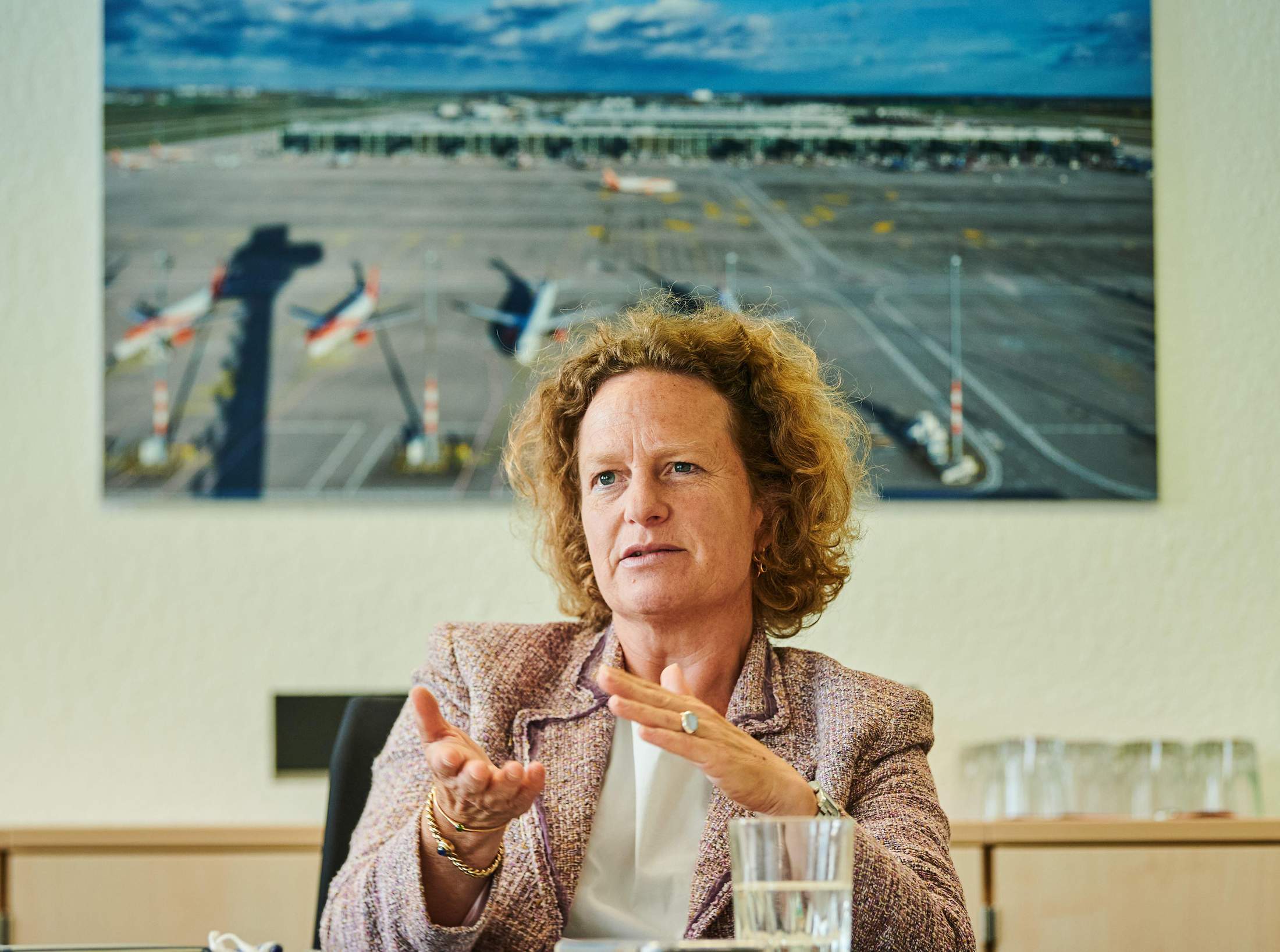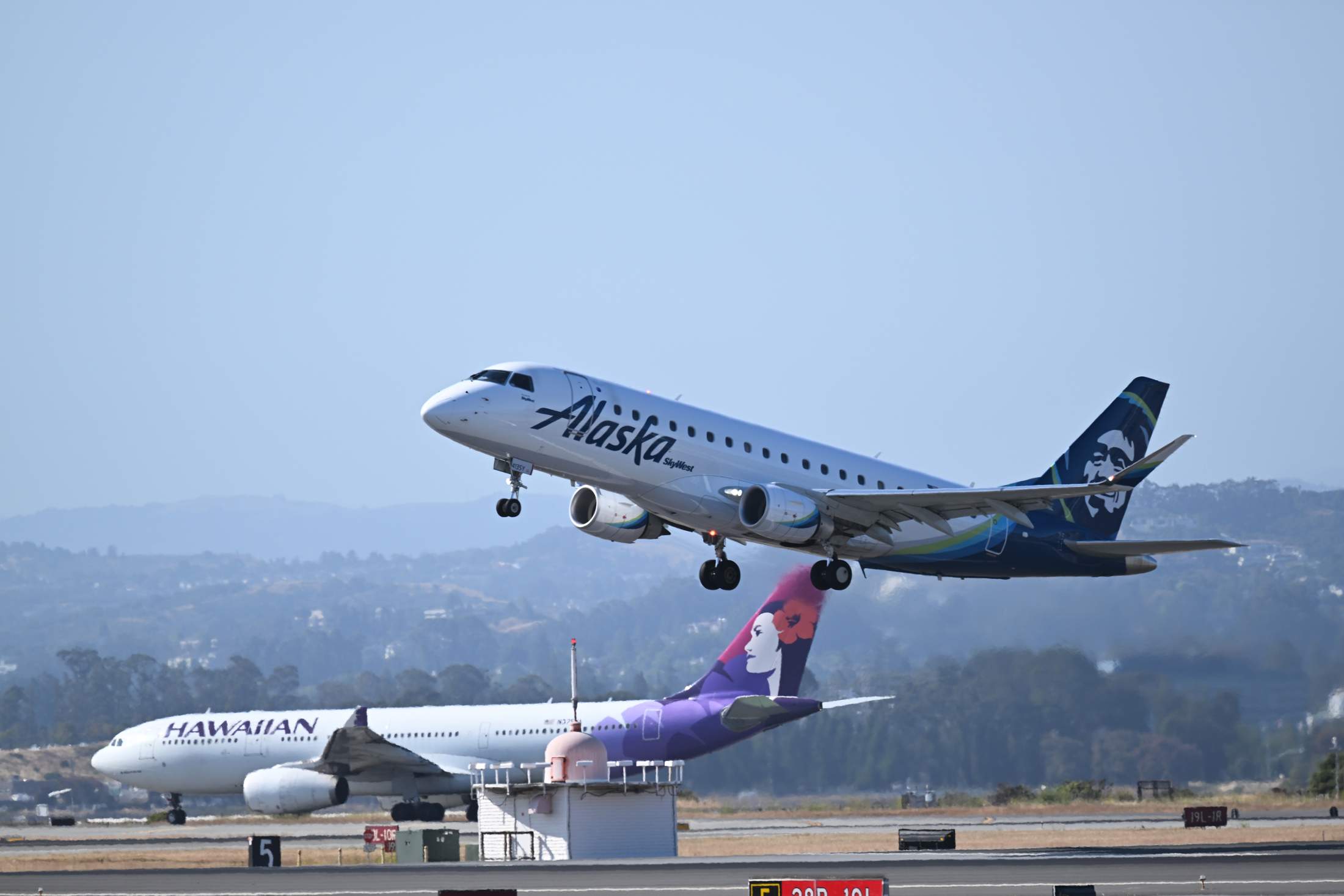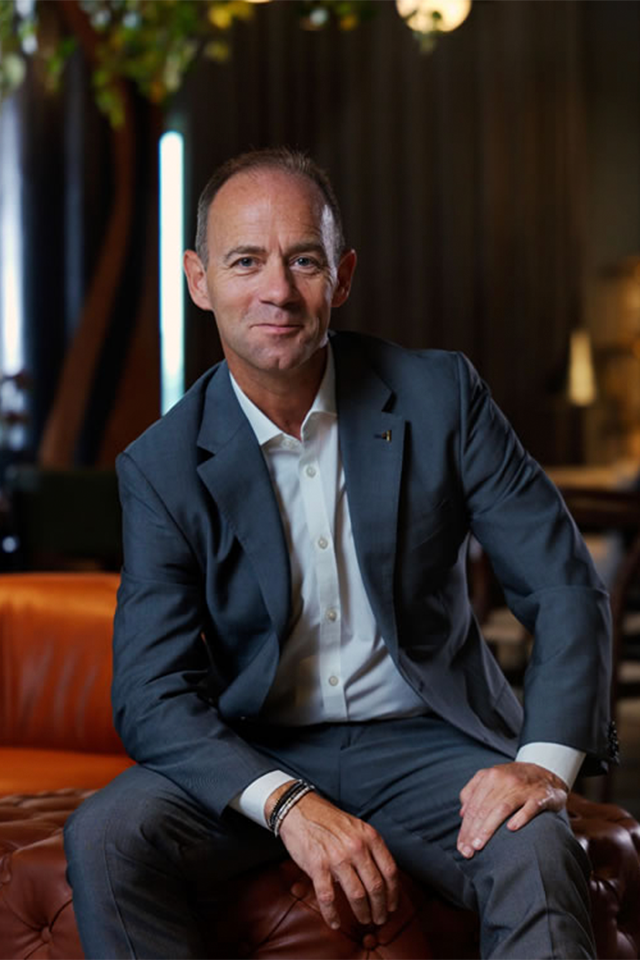February / Global
The Agenda: Business
A course correction for Berlin Brandenburg Airport, rethinking men’s skincare and behind the scenes at international hotel brand Fairmont.
Better late than never

For years, the safest conversation starter in Germany’s capital has been to commiserate about Berlin Brandenburg Airport. There’s plenty to talk about: you can kick off by mentioning the hour-long security queues, ease into lamenting the shoddy public-transport connections and the illogical signage, and then spend the rest of the time marvelling at the epic quagmire that led the airport to start operating 9 years behind schedule. Aletta von Massenbach (pictured) took on one of the least enviable jobs in town when she stepped in as the airport’s CEO in 2021, a year after its opening. “If you didn’t have a clue how to make it better, it would have been overwhelming,” she says from a boxy conference room overlooking Terminal 1. “We had a plan.”
The efforts of Von Massenbach, who has experience managing many airports around the world (and is the first woman to lead a major one in Germany), are gradually becoming tangible to travellers. In an official ceremony in October, the federal police relinquished its responsibility for operating security control and the lanes are being redesigned and updated with state-of-the-art X-ray machines. While Berlin lags behind hubs such as Munich and Frankfurt, new flight routes are being added to the schedule at a fast clip.
Another urgent task has been to boost staff morale. “Normally, people are very proud to say they work in aviation,” says Von Massenbach. “Our employees didn’t even dare say where they were working.”
But no amount of management wizardry is likely to quench the criticism of Berliners. Many nostalgists are happy to wax on for hours about Tegel, the city’s decommissioned 1970s airport and view its replacement as an avatar for everything that is going wrong in the country. “It was for far too long a not very good example of Germany’s capability to manage big projects,” says Von Massenbach. “I don’t take it personally.” The CEO’s phlegmatic attitude appears to have paid off. After years of failure, things at Brandenburg seem to finally be looking up.
laura kramer on...
Rethinking men’s skincare
New year brings with it personal-transformation resolutions, with renewed gym memberships and promises to cut down on apéro topping the list. But health doesn’t stop at losing kilos; the biggest organ of the body is often overlooked. Dutch founder Gregor Jaspers is on a mission to change that with The Grey, his luxury men’s skincare line that he launched in 2018.
The idea came on a work trip to Milan Fashion Week when Jaspers realised that there was a gap in the market for a compact men’s skincare line, which matched his need for efficient products that would fit into his small suitcase. “I was a buyer for a department store in the Netherlands and travelling extensively. I looked at my cluttered wash bag filled with women’s, unisex and men’s products, some packed in golden jars with massive lids and only 50ml of eye cream in them.” He realised that there wasn’t a tailored solution for men who wanted high-performance products without the frills. “I felt neglected and ignored as a male consumer.”


This sparked his desire to create a line blending the efficacy of luxury skincare with simplicity and convenience for a straightforward routine. “I asked the developers at the laboratory to make a single product containing all of the different moisturisers I’m using for the day, night and eyes. That became our three-in-one face cream and it’s an absolute best seller, a pillar of the brand.”
Today, The Grey offers products featuring botanical and active ingredients, with formulas that quickly absorb into the skin and don’t adhere to facial hair. “We get messages from clients who have skin issues so we developed the Comfort+ cream especially for them. And we get the most emotional emails from guys whose skin we fixed. So that’s why we do it.”
It’s since expanded offerings from men’s grooming products to an SPF cream that took three years to develop, supplements and teas that promise to nurture skin from the inside out. “Men should take care of themselves in every aspect of their life,” says Jaspers. “And I think telling that story all over the world is what makes me eager to go to the office every morning.”
thegreymensskincare.com
To hear more from inspiring business folk, tune into our weekly radio show, ‘The Entrepreneurs’, at monocle.com/radio
Two of a kind
The largest passenger air carriers in two of the more remote corners of the US are planning to merge in a landmark deal announced in December. Alaska Airlines, which was founded in Anchorage in 1932 and is headquartered in Seattle, intends to buy Hawaiian Holdings, the parent company of Hawaiian Airlines, for $1.9bn (€1.76bn).

The importance of each airline runs deep in their respective states, given that the regions have been more reliant on air travel than the rest of continental US – the only way to navigate the Hawaiian archipelago before the airline’s launch in 1929 was via steamship. The deal, therefore, feels like a good fit.
Alaska Airlines is the fifth-largest carrier in the US and this is an opportunity for it to expand its reach beyond routes along the North American west coast, as well as across Alaska’s remoter regions. The combined carrier will grow Alaska Airlines’ fleet to 365 aircraft and will transform Honolulu into a major air hub, thanks to Hawaiian Airlines’ connections with both the US west coast and the Asia-Pacific region, including its longstanding routes to cities such as Tokyo, Osaka, Seoul, Auckland and Sydney.
If the deal is greenlit by US regulators, who are expected to rule on whether the deal aligns with US monopoly regulations in the first quarter of 2024, it will create a major new competitor in US aviation, which has recovered robustly from the turbulence caused by the pandemic.
Importantly, however, Alaska’s proposed acquisition of Hawaiian Holdings will see each airline retain its individuality and branding, meaning that the two legacy airlines will continue to fly the flag for their respective regions, much like they have done for close to a century.
HOSPITALITY ––– GLOBAL
Q&A
Mark Willis
CEO, Fairmont

Few international hotel brands can match the often castle-like properties of Fairmont, which first flung open its doors in San Francisco in 1907. ceo Mark Willis tells monocle about Fairmont’s extensive expansion plans and explains why, shortly after taking up his post, he moved its global HQ from Paris to Dubai.
You moved Fairmont’s global HQ to Dubai. Why?
Globally, Dubai is a very central location. We have hotels all over the world; we have owners all over the world who we need to interact with in person. We have about 30 hotels opening in the next 36 months. It’s a great hub do that from. We’re also able to recruit great talent here.
Where will Fairmont’s newer outposts open in the next three years?
We’ve been careful with where and how we grow the brand. Among the portfolio that’s due to open are Geneva and Prague, which are full renovations, and an amazing new 500-room hotel in Bangkok. We have an opportunity to grow in new locations – Miami and Las Vegas in the US; Paris and Berlin in Europe; and Phuket, Kuala Lumpur, Bali and other destinations in the Middle East.
What is one aspect of the hotel sector where you see opportunities for growth?
We are actively looking at how to retain the best members of our teams and how people can work in different ways to make the roles stimulating and to offer opportunities to grow. It’s a wonderful industry. We need to encourage younger team members to come in and work within it.
fairmont.com
ARCHITECTURE ––– JAPAN
History reimagined
Fed up with seeing old homes being demolished in Japan, Tomohiro Fujii, a Central Saint Martins graduate, decided to take action. Together with consultant Shori Fuji, he set up Kessaku (“masterpiece” in Japanese), a company that aims to protect historic houses by offering shared ownership.

Fujii’s idea is to offer people the chance to buy a stake in a property from as little as ¥1,000 (€6.40); depending on the amount they put in, co-owners would then be able to stay a certain number of days per year. The properties will be everything from a traditional Japanese house to an architect-designed home from the 1970s and Kessaku will take care of management and maintenance. “There are plenty of people like us who want to look after old buildings but don’t have the time or the resources to take one on by themselves,” he says.
“There’s a change towards valuing older buildings and we would like Kessaku to be part of that transition”
The first property on offer is a wooden house in Nagano from the 1930s (pictured) that belonged to a lacquer craftsman. With nobody to inherit it, there was a danger of it falling into disrepair. “It’s a beautiful house,” says Fujii. “We want to restore it and make it comfortable.” Many owners find that registering a building as a historic property is more trouble than demolition. In Tokyo, where land is more highly valued than buildings, the problem is acute and old houses are disappearing fast. Fujii says that tourism is helping as visitors are keen to stay in historic homes. “There’s a change towards valuing older buildings and we would like Kessaku to be part of that transition.”
kessaku.casa


